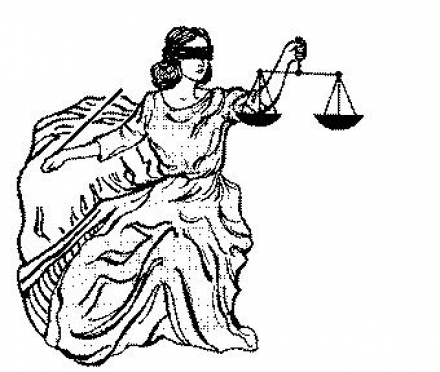Concerning a possibly spurious decision of the European Court of Human Rights
On the morning of 2008-12-24 Elzbieta Jurgelevičienė, a citizen of the Republic of Lithuania, received an especially strange letter from the European Court of Human Rights.
1. The very text of the letter received from the European Court of Human Rights in Strasbourg by Elzbieta Jurgelevičienė on the morning of December 24th, 2008, was drawn up in Strasbourg December 23rd, 2008 (which fact is confirmed by the date of this letter mentioned in the text). On the morning of December 24th, 2008 this letter arrived in the village of Tabariškės, district of Kaunas. This means that a letter sent in Strasbourg, France, by post, did travel only one day minus several hours to reach the place of residence of the above applicant. We asked employees of the central post-office of Kaunas, whether such a speedy delivery of a letter is at all possible. These people assured us that no letter from Strasbourg to Kaunas has ever arrived before the elapse of at least 4 days. As the time in question falls within the period of sending Christmas greetings, this time will be considerably longer. That is why there is only one conclusion to be drawn from these facts: this European Court of Human Rights document was not sent from Strasbourg, but from Lithuanian territory.
2. As can be seen from the text of the European Court of Human Rights letter received by Elzbieta Jurgelevičienė on the morning of December 24th, 2008, one should most likely interpret it as a decision adopted by this selfsame court (beginning of quotation):
„ Second Section
ECHR-LLitll.OR(CDl) MCE/RTM/jp Strasbourg, 2008 m. December 23rd.
Application Nr. 40751/07 Jurgelevičienė vs. Lithuania
Dear Mrs. JURGELEVIČIENE,
We wish to inform you that a committee of three judges of the European Court of Human Rights, consisting of judges (V. Zagrebelsky, Chairman, D. Popovič ir N. Tsotsoria), sitting on December 16th, 2008, have decided to declare your application inadmissible in accordance with article 27 und 28 of the Convention, as it does not meet the requirements laid down in articles 34 and 35 of the Convention.
After checking the whole material of this case, the Court decided that the application does not show any violation of any rights or freedoms guaranteed by the Convention or its protocols.
This decision is final and can neither be appealed against to the Court nor to any other institution. Therefore, we ask you to understand that the registry of the Court cannot furnish more detailed information about the committee”˜s session or about the adopted decision. The Court will henceforth not send you any documents concerning this case, moreover, according to the Rules of procedure of the Court, the case file will be deleted after the elapse of one year following the date of this decision.
This communication was drawn up in accordance with article 53 § 2 of the Rules of procedure of the Court”.
Yours truly,
For the Committee
Signature copied F. Elens-Passos Deputy
Section registrar (unquote).
Scanned copies of both the letter sent by the ECHR and the envelope, in which it travelled, are published in the personal homepage of Z. Jurgelevičius: http://zenonas.visokybes.com/image/index .
The fact that the document received by E. Jurgelevičienė on December 24th, 2008 is not qualified as a judgment or decision of the Court, but is no more than a letter by the deputy of an unnamed registrar with a signature copied into this letter, leads us to doubt, whether this is really the official position in a decision of the European Court of Human Rights regarding an especially serious problem of law? The „application” of August 28, 2007 to the ECHR, submitted by Elžbieta Jurgelevičienė contested the validity of two legally unfounded laws, adopted and implemented in the name of the Lithuanian state. That way illegal acts ” which the Soviet-Lithuanian nomenklatura had carried through against her people after the end of Second World War (the period of the second Soviet occupation) – are both being legalized and their continued duration implemented in post-soviet Lithuania.
The facts contested in the application of August 28, 2007, submitted by Elžbieta Jurgelevičienė to the ECHR, are a part of these illegal acts. The resolution Nr. 1481 of 2006, adopted by the Parliamentary assembly of the Council of Europe, called such acts „crimes committed by totalitarian Communist regimes”. This is why one cannot believe that such a respectable legal institution like the European Court of Human Rights would show no reaction as regards the legalization of the results of the crimes perpetrated by a totalitarian regime and the continuance of these crimes within the European union.
In order to convince oneself of the fact that the officials of Lithuanian government, administrative and judicial institutions did in fact perpetrate the violations of the European Convention of Human Rights, on grounds of which E. Jurgelevičienė had submitted her application to the ECHR – it is sufficient to acquaint oneself with the content of the 2cassation appeal” submitted to the Supreme Court of Lithuania by the professional law specialist and lawyer Å . Vilčinskas on January 30th, 2007. Each single detail referred to in this cassation appeal is well-founded (shown) by means of the content of each corresponding document attached. The above mentioned „cassation appeal” was published under this link: http://zenonas.visokybes.com/wiki/1285/329_KASACINIS_SKUNDAS .
Confirmation of the falsification of the legal essence of the legal acts of the period of Soviet occupation, perpetrated within the post-Soviet period (after March 11th, 1990)
I. Confirmation by means of documents from the period of Soviet occupation. One can convince oneself of the fact that the Soviet occupational regime in Lithuania did not carry through a general and simultaneous nationalization of the landed property of the people in 1940 – by studying the July 22nd, 1940 declaration of the People”˜s Seimas of the occupational regime „Concerning the taking of the land into the property of the state” and the content of the resulting legal acts regulating its implementation. However, don”˜t let you be led astray by the name of this declaration. In 1940 the Soviet occupational regime did merely carry through a Soviet land reform, only the landed property of the people exceeding the norm of 30 hectares was surrendered into the state land fund. For the legal formation of each single portion of a concrete landed property having been taken over into the state land fund, a separate document confirmed by legal acts had to be drawn up in 1940. This is proven by the texts of the post-law acts concerning the implementation of the above mentioned declaration (each of these have been scanned and published in the internet http://www.straipsniai.lt/1940/deklaracijos/ ) (quote):
„Expressing the will of the working people and being guided by the vital interests of the working farmers, the People”˜s Seimas declares the entire Lithuanian land including the space under it, all forests and waters the property of the people, i.e. the property of the state. From this day the land will belong to those, who cultivate it.
The People”˜s Seimas decides to fix a norm of 30 hectares for each single farmstead of all the farmsteads in Lithuania, and to form a state land fund out of the surplus land of the farmsteads exceeding this norm, in order to help the landless peasants as well as the smallholders to acquire land.
The entire land, which from this day is in the possession of the working people or the farmers, as well as the land, which the state gave to the landless peasants and the smallholding farmers, is confirmed to be for their eternal use. All attempts to infringe upon the personal property of the farmers, or to impose upon the working farmers a kolkhoz system against their will, shall be severely punished for harming the interests of the people and the state.”(unquote).
The legal status of the landed property of the citizens had also been laid down in 1940 in the legal norms of articles 9 and 10 of the constitution of the Lithuanian Soviet Socialist Republic (the supreme legal act according to its legal validity):
Article 9: „The land, occupied by the farmsteads of farmers, is being confirmed to be for their use within the scope of the law, free of charge and for an unrestricted time”.
Article 10: „The law protects the personal ownership rights of the citizens to the earnings of their work as well as to their savings, to a family home and a plot of land for subsistence, to farm equipments and household fittings, to things for personal use and convenience, and it also protects the personal ownership right of the citizens.”
There is an additional explanation of this article of the constitution. On December 5th, 1940 the then Soviet people”˜s commissary for justice, Povilas Pakarklis, explained the more important regulations of the Constitution of the Lithuanian Soviet Republic on page 9 of Nr. 151 of the daily newspaper „Tiesa” („The Truth”):
„5. The question of property in the constitution of the LSSR:
Article 10 of the Constitution of the Lithuanian Soviet Republic stipulates that the personal property of the citizens is being protected by the law. This ruins the assertions of the enemies of socialism that there is no property within the framework of the Soviet order.
Within the framework of the Soviet order no one has the right to rob workers, farmers or employees of the money they have earned. Also does no one have the right to throw a farmer out of his farmstead and to occupy it for himself. Within the framework of the Soviet order personal property is not inconsistent with socialistic property, it is fully a product of it: in the end it is the result of the participation of workers and farmers in socialistic production, it is the product of their work”.
In neither of these documents nor in the post-law acts regulating the implementation of the „Declaration” by the People”˜s Seimas of July 22nd, 1940 the legal term „nationalization” was not used, as at that time only a Soviet land reform was carried through. The so-called general and simultaneous nationalization of the landed property of Lithuanian citizens of the year 1940 was thought up and implemented retrospectively only after March 11th, 1990 (the restoration of the independent Lithuanian state) by a small part of the Soviet nomenklatura, calling themselves the only Lithuanian patriots.
II. Confirmation by three authoritative Lithuanian patriots.
1. The first source of confirming information and the information distributed: At 9:28 in the morning of June 23rd, 1940, through the Kaunas radio station, Leonas Prapuolenis, in the name of the „Front of Lithuanian Activists” declared the restoration of the independent Lithuanian state, liberated from Soviet occupation, and the composition of the provisional government. Juozas Ambrazevičius (Brazaitis) was to take the post of minister of education in this government. It was not until recently that we learned anything about the events of this time. By force of arms and within an unbelievably short time the government was regained and the restoration of the independent state proclaimed. A provisional government of the republic was formed, headed by Kazys Å kirpa as prime minister. The Germans, however, did not let him return to Kaunas, which is why minister of education Juozas Brazaitis acted as prime minister for the time being.
The provisional government of Lithuania was in control of the situation in the country, acting as a safeguard for the upkeep of social order, as it was both the moral and legal authority of this order. Nominally speaking, it performed its function for six weeks. On September 5th, 1941, Dr. von Renteln, general commissar of the Reich in Lithuania, invited the members of the Lithuanian government and offered J. Brazaitis, to become his general counsellor. J. Brazaitis, however, declined this offer by giving as an argument that his legal powers were valid only for the independent Lithuanian state. With that the official function of J. Brazaitis and the Provisional government ended.
On pages 47-48 of his book „Vienų vieni” („Quite alone”), published in 1964 in the US. under the pseudonym N. E. Sūduvis, J. Brazaitis acknowledges the following historical facts (quote):
… „in declaration VII.22 of the „People”˜s Seimas”: ” The People’s Seimas declares the entire Lithuanian land including the space under it, all forests and waters the property of the people, i.e. the property of the state.” „The „People”˜s Seimas” decides to fix a norm of 30 hectares for each single farmstead of all the farmsteads in Lithuania, and to form a state land fund out of the surplus land of the farmsteads exceeding this norm, in order to help the landless peasants as well as the smallholders to acquire land”. The declaration, however, when mentioning kolkhozes, stresses that: „All attempts to impose upon the working farmers a kolkhoz system against their will, shall be severely punished”.
603.590 hectares of land, confiscated from 28.000 land-owners, owning 1.240.000 hectares were surrendered into the land fund, this was 15% of all agricultural land. 61.000 farmsteads comprising 20-30 hectares as well as 40.000 farmsteads comprising 15-20 hectares retained their whole land.
However, the plans to distribute the land surrendered into the land fund, were unsuccessful. That is why, on August 29th, 1940, the council of commissars did oblige the owners of the undistributed plots of land to once again carry through the autumn tilling and sowing of the fields at their own expense. (unquote).
The unquestionable conclusion: The Soviet occupational regime, in 1940, did not perform any general and simultaneous nationalization of the land in Lithuania.
2. The second source of confirming information was published by the former chief of the „Radio Free Europe” news desk and the former editor-in-chief of the Lithuanian section, (now member of the Academy for Lithuanian Catholic Studies, doctor of philosophy and lecturer of Vilnius university) Kęstutis Girnius, Chicago, USA, „Towards Freedom” foundation, in 1987 in his book: „Partizanų kovos Lietuvoje” („The struggle of the partisan in Lithuania”), on pages 145 – 146 (quote):
„…Up to February 1st, 1946 just somewhat more than one million hectares of agricultural land had been surrendered into the state land fund. This fund comprised the land taken away from the churches, the so-called hitlerites and enemies of the people, and land belonging either to abandoned farmsteads, to former repatriates to Poland or to resettlers from the area of Klaipėda, as well as all the land exceeding the norm (of 30 hectares). As late as 1946 almost all the land belonging to „hitlerites” and the churches as well as the land exceeding the norm had been taken away. At that time all Germans had also left the area of Klaipėda. Actually the land reform of the communist regime should more or less have been carried through within one and a half year. However, from the beginning of 1946 until November 1948 the state land fund increased by yet another half million hectares of land, out of which more than two hundred thousand hectares (213.844) were surrendered into the land fund within the period of March to November 16th, 1948. This was mostly the land of farmer, who had forcibly been displaced to Siberia ” as the repatriation to Poland had more or less ended in 1947. One can find out the approximate number of the displaced persons by calculating the average size of a farmstead. One should be reminded that a farmstead only rarely was bigger than 20 hectares at the time of the land reform. January 1st, 1948 only 4.6% of the farmsteads comprised more land (171:87). Among the forcibly displaced persons were also owners of small and middle-sized farmsteads as well as families, whose farmsteads had been downsized to only 5 hectares, as the head of the family was a partisan or at least regarded to be a partisan. By availing oneself of these figures one can calculate that the size of a normal farmstead of a displaced person did not exceed 10 hectares. That way about 20.000 farmers lost their farmsteads from March to November 1948. When calculating that a family had four members on an average, one can draw the conclusion that about 80.000 people were forcibly displaced within that period.
This is only an approximate calculation, as the land of farmer, which had not been displaced, had also been surrendered into the land fund, for example, the land of those farmers, who had abandoned their farmsteads, afraid of being arrested for not being able to pay taxes. In some cases the farmsteads of killed partisans were downsized to 5 hectares, although their families were not at once displaced to Siberia. In further instances, communist activists and „istrebiteli” (members of NKVD-sponsored „search-and-kill”-unit is why this land was not surrendered into the land fund …” (unquote).
And once again the undeniable conclusion: as even after the end of World War II landed property of the rightful Lithuanian land-owners was still being surrendered into the state land fund ” this proves that no general and simultaneous nationalization of the landed property, rightfully owned by Lithuanian land-owners, was carried through in 1940.
3. The second source of confirming information appeared in the form of a book published in 1992 by publishers „Mintis” under the title „Daugel krito sūnų” („Many sons were killed”) written by A. Ramanauskas-„Vanagas” (the last leader of the armed resistance against the Soviet occupying forces, who was caught in October 1956 and shot November 29th, 1957), page 105 (quote):
„…One has to mention that it cut the partisans to the quick when registering (i.e. with the organs of the occupational regime). Their self-esteem was the same as that of each farmer, whom the Soviet regime „admitted” to a kolkhoz „of his own free will”. (unquote).
Conclusion: the membership of land-owners in the Soviet kolkhozes was of a so-called „voluntary” nature. This means that after the self-dissolution of these collective formations in 1990, the whole land would have to be returned to the rightful owners of this land or (when the owners had already died) to the heirs.
III confirmation. Towards the end of 1996, a working group of the Lithuanian Association for the Defence of Human Rights (LŽTGA), specializing in the defence of owners”˜ rights (headed by me), ” came across the original document of both the above mentioned „Declaration” by the „People”˜s Parliament” of July 22nd, 1940, and the texts of the post-law acts regulating its implementation, which had up to that time been withheld from the general public. No sooner had the then „lawgivers” learnt that the original text of that „Declaration” of July 22nd, 1940 had been unearthed, they immediately (January 16th, 1996) adopted a law Nr. VIII-76 suspending the law of June 18th, 1991 „Concerning the regulations and conditions of the restoration of the ownership rights of the citizens to their still existing land „ and the validity of its subsequent modifications and additions (quote):
„For the time of the period in force of this law:
1) is suspended the restoration of ownership rights to still existing real estate, as well as the resolution of the problem of privatization of landed property, the ownership rights of which were be restored to owners according to Lithuanian laws, and of apartments in houses which were to be returned to their owners, in all boards, institutions and organizations of the Lithuanian Republic;
2) are deferred all hearings of civil cases, in connection with the law” „Concerning the regulations and conditions of the restoration of the ownership rights of the citizens to their still existing land” in all courts of the Lithuanian Republic, according to actions, claims, applications, appeals, cassation appeals and proposed cassations;
3) is deferred the enforcement of final court judgments, and suspended the enforcement of decisions of boards, institutions and organizations, in connection with the law „Concerning the regulations and conditions of the restoration of the ownership rights of the citizens to their still existing land” (unquote).
Especially interesting as well as important from a legal standpoint is part three of this law. Its legal essence corroborates the fact that both the officials of the post-soviet Lithuanian regime as well as the members of the administration of justice do understand perfectly well that the machinations carried through by themselves, by means of which the land is taken away from the land-owners, are absolutely unjust acts.
The special law of the Republic of Lithuania Nr. VIII-359 of July 1st, 1997, which had modified the suspended law of June 18th, 1991, again put into force the legal continuation of all former decisions regarding the so-called „restoration of rights of ownership”. This means that from that moment onwards the Lithuanian politicians and jurists did not chose to realize the implementation of truth and justice, but the continuation of the illegal machinations carried through by the Soviet nomenklatura in the years following the end of World War II, an inseparable part of which is the confiscation of the land of the political opponents (or people regarded to be such) murdered by the selfsame nomenklatura after World War II. The whole course of events has been taken place in the twenty-first century, on the territory of a state, on which the legal acts of the European Union are not only valid, but are of supreme legal validity …
There is only one common conclusion to be drawn from the information disclosed in this article:
Both the information incorporated in the laws of the post-soviet Lithuanian republic and in the decisions of the Lithuanian Constitutional Court, as concerns the so-called general and simultaneous nationalization of the land holdings of the rightful Lithuanian land-owners, carried through by the Soviet occupational regime in 1940, is untruthful.
The only reason for the Lithuanian applications submitted to the European Court for Human Rights, as concerns the violation of ownership rights is the arbitrary behaviour of the administrative and judicial officials of post-soviet Lithuania, spitting on justice.
When evaluating all circumstances and facts made public in this article, the well-founded question arises: who can guarantee that – in the morning of December 24th, 2008 – Mrs. Elzbieta Jurgelevičienė really received a document adopted and sent by the European Court of Human Rights ” and not the forged surrogate of a document (containing only what is useful for their purposes), sent by those, who are continuing the crimes committed by the totalitarian Soviet regime?
Zenonas Jurgelevičius
Member of the Lithuanian Centre for Human Rights














